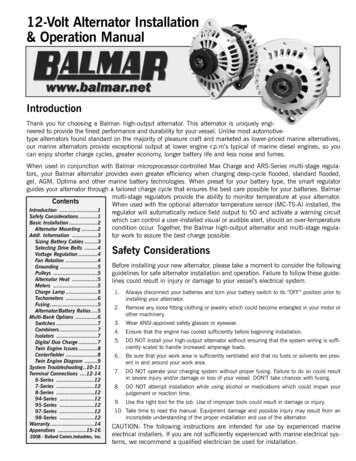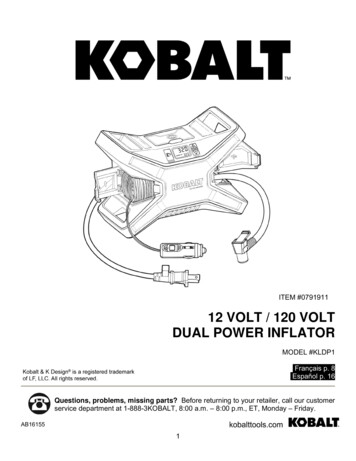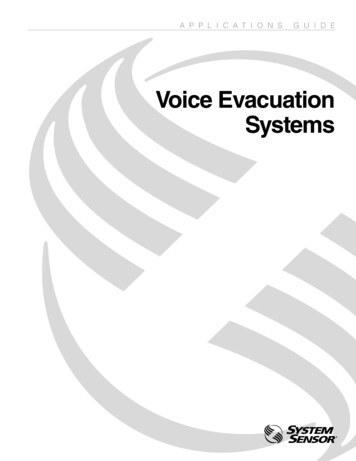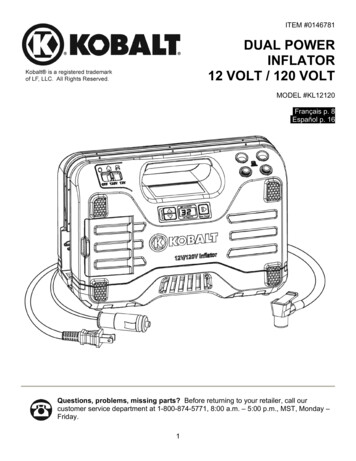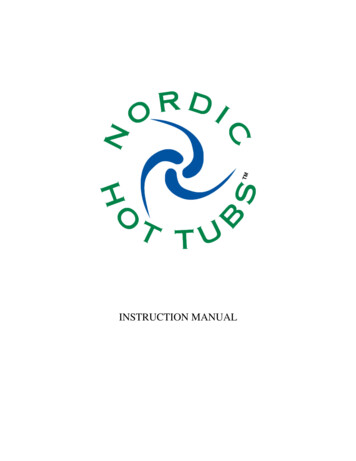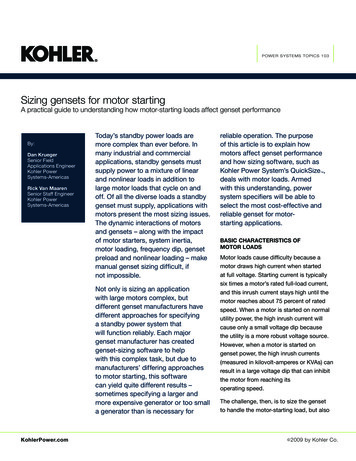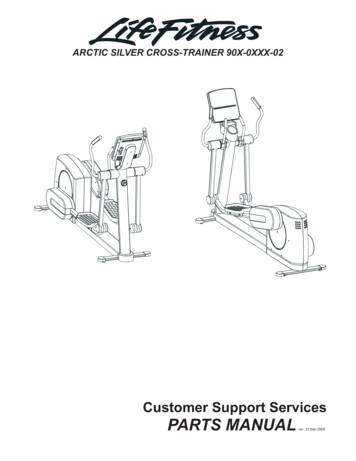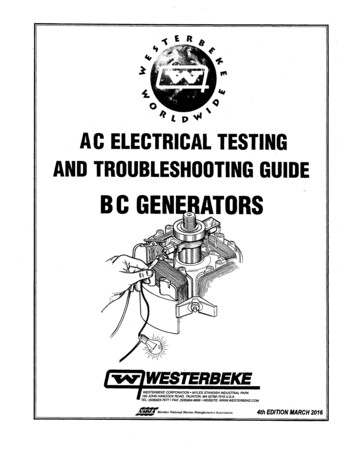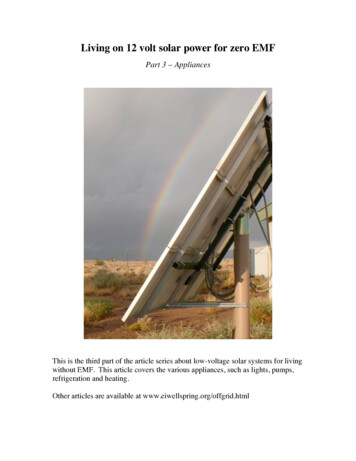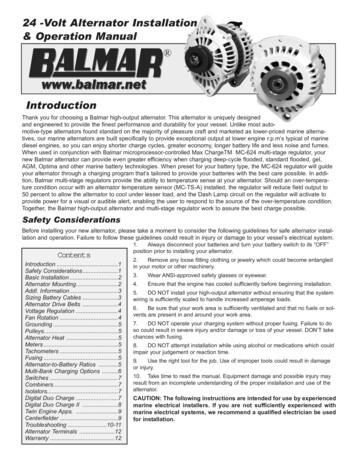
Transcription
24 -Volt Alternator Installation& Operation Manual IntroductionThank you for choosing a Balmar high-output alternator. This alternator is uniquely designedand engineered to provide the finest performance and durability for your vessel. Unlike most automotive-type alternators found standard on the majority of pleasure craft and marketed as lower-priced marine alternatives, our marine alternators are built specifically to provide exceptional output at lower engine r.p.m’s typical of marinediesel engines, so you can enjoy shorter charge cycles, greater economy, longer battery life and less noise and fumes.When used in conjunction with Balmar microprocessor-controlled Max ChargeTM MC-624 multi-stage regulator, yournew Balmar alternator can provide even greater efficiency when charging deep-cycle flooded, standard flooded, gel,AGM, Optima and other marine battery technologies. When preset for your battery type, the MC-624 regulator will guideyour alternator through a charging program that’s tailored to provide your batteries with the best care possible. In addition, Balmar multi-stage regulators provide the ability to temperature sense at your alternator. Should an over-temperature condition occur with an alternator temperature sensor (MC-TS-A) installed, the regulator will reduce field output to50 percent to allow the alternator to cool under lesser load, and the Dash Lamp circuit on the regulator will activate toprovide power for a visual or audible alert, enabling the user to respond to the source of the over-temperature condition.Together, the Balmar high-output alternator and multi-stage regulator work to assure the best charge possible.Safety ConsiderationsBefore installing your new alternator, please take a moment to consider the following guidelines for safe alternator installation and operation. Failure to follow these guidelines could result in injury or damage to your vessel’s electrical system.ContentsIntroduction .1Safety Considerations.1Basic Installation .2Alternator Mounting.2Addl. Information.3Sizing Battery Cables .3Alternator Drive Belts .4Vottage Regulation .4Fan Rotation .4Grounding .5Pulleys.5Alternator Heat .5Meters .5Tachometers .5Fusing .5Alternator-to-Battery Ratios .5Multi-Bank Charging Options .6Switches .7Combiners.7Isolators.7Digital Duo Charge .7Digital Duo Charge II .8Twin Engine Apps. .9Centerfielder .9Troubleshooting .10-11Alternator Terminals .12Warranty .121.Always disconnect your batteries and turn your battery switch to its “OFF”position prior to installing your alternator.2.Remove any loose fitting clothing or jewelry which could become entangledin your motor or other machinery.3.Wear ANSI-approved safety glasses or eyewear.4.Ensure that the engine has cooled sufficiently before beginning installation.5.DO NOT install your high-output alternator without ensuring that the systemwiring is sufficiently scaled to handle increased amperage loads.6.Be sure that your work area is sufficiently ventilated and that no fuels or solvents are present in and around your work area.7.DO NOT operate your charging system without proper fusing. Failure to doso could result in severe injury and/or damage or loss of your vessel. DON’T takechances with fusing.8.DO NOT attempt installation while using alcohol or medications which couldimpair your judgement or reaction time.9.Use the right tool for the job. Use of improper tools could result in damageor injury.10. Take time to read the manual. Equipment damage and possible injury mayresult from an incomplete understanding of the proper installation and use of thealternator.CAUTION: The following instructions are intended for use by experiencedmarine electrical installers. If you are not sufficiently experienced withmarine electrical systems, we recommend a qualified electrician be usedfor installation.
Installation InformationPage 2Basic InstallationAlternator MountingDue to the many domestic and international configurations of engine/alternator mounts, and factors such as year and location of engine manufacture and marinization, Balmar cannot guarantee a drop-in replacement in every engine application. Choose the model that most closely fitsyour application. Your installer may have to adapt the basic mounts to fit your needs. The majority of marine engines are equipped with one of four alternator mounting styles. The followingdescribes which alternator represents each specific mounting style:1.60-Series (Dual Foot w/3.15” between legs): Small Case. Replaces most small case styles usinga saddle style mount (eg., Hitachi, Lucas, Mitsubishi).2.61-Series (1'' Single Foot): Small Case. Replaces most domestic styles using a single 1" mounting foot (eg., Motorola, Prestolite).3.612-Series (2'' Single Foot): Small Case. Replaces most domestic styles using a single 2" mounting foot (eg., Delco).4.94-Series (2'' Single Foot) Series: Large case. See case dimensions on our website at www.balmar.net to determine if your engine can accommodate the large case alternator.5.97 & 98-Series (Dual Foot w/4'' between feet) Series: Extra large case. See case dimensions atwww.balmar.net to determine if your engine can accommodate an extra-large case alternator.604, 97, 98-SeriesIf you determine that the desired alternator will just not replace the existing alternator, one excellent option may be to leave the existing alternator in place and purchase a dual groove crankpulley for the front of the engine (in addition to the existing pulley). Have a special mount fabricated, or use the Balmar remote Alternator Bracket #-5276, to accommodate a larger alternator.Once you have determined that the new alternator is the correct replacement for your existingmodel:60-Series1.Disconnect the batteries and/or turn the switch to the “OFF” setting. Disconnect the wiring fromthe existing alternator.2.Loosen the mounting & tensioning bolts and remove the existing alternator.3.Once the alternator is disconnected from the engine, compare its mounting points to those onyour new Balmar alternator. In most applications, the new alternator will replace the old alternatorwithout any modification. In some cases, a simple bracket can be fabricated by a local machineshop. Balmar offers a universal mounting arm which can replace your existing tensioning arm, ifneeded. Others can be obtained through your local auto or marine supply.4.Attach the mounting foot of the new alternator to its engine mount. Some shimming may be necessary to ensure that the alternator is securely mounted within the engine mount. If your alternator is a dual foot style, use care when tightening the alternator in place that the twomounting ears are not compressed. The rear bushing is designed to slide to tighten themount.5.Once in place, inspect to ensure that the alternator pulley is properly aligned with the engine pulley. If your belt configuration includes the pulley for the water pump, make sure that all three pulleys are properly aligned. Some shimming or modification to the alternator mount may berequired to assure proper alignment.6.Connect the output cable (see cable sizing recommendations below) ground, field wire, stator(tach) wire if needed and other necessary wiring. Connect alternator to Balmar regulator wiringharness as indicated in wiring diagram included on Page 12. The alternator’s positive and groundcables should be sized according to the chart on Page 3.7.If a new regulator is being installed along with the alternator, complete its wiring installationaccording to the instructions included with your regulator.612, 94-Series61-Series
Page 3Belt Adjustment/Battery CablesAfter the alternator is installed and the wiring connections are attached, inspect the pulley for proper tension.When changing pulleys or when using the factory-installed pulley, torque the shaft nut to 50-60 foot-pounds.The shaft nut measures 15/16''. To install the belt:1.Loosen the adjustment arm bolt and alternator pivot assembly bolt.2.Fit a new, high-quality belt over the appropriate pulleys.3.Tension the alternator until the belt is securely tightened in place. Retighten the pivot assembly and tension arm bolts. To test tension, placea 15/16'' wrench on the alternator shaft nut and apply pressure. If thepulley rotates without moving the belt, re-loosen the bolts, apply additional pressure and re-tighten. Repeat until the belt is properly tensioned.4.Verify proper tension by pushing on the outside surface of the belt. Thebelt should deflect approximately 1/4” to 5/16” under moderate pressure. Your local auto parts store may carry a measuring tool designedto gauge belt deflection.5.Ensure that the Mounting bolts at the alternator’s pivot point aresecurely re-tightened.Belt Tension AdjustmentFor ease of belt installation, you may want to invest in an inexpensive belt tensioning tool like that sold by J.C. Whitney (www.jcwhitney.com). This simple tensioner provides positive support at the alternator while increasing belt tension, leaving two free hands to re-tension mounting and tensioning belts.Your belt will tend to stretch during the first several times you run your engine. Make it a part of your normalpre-flight check to test belt deflection and re-adjust belt tension when needed. If you notice an accumulationof black belt on your alternator and surrounding engine area, check belt tension. If the belt is tensioned andyou still experience belt dusting, it may be necessary to reduce horsepower load on your belt with the regulator’s Amp Manager function (if equipped), or you may find that a different brand of belt may work more effectively with your charging system7. See additional information on Page 4.Additional Installation InformationSizing Battery CablesThe addition of a high-output alternator to your charging system may make it necessary to increase the sizeof your battery cables to increase the system’s amperage carrying capacity. To determine the proper cablesize, consider BOTH cable length and alternator capacity. Both positive and negative wire runs must beincluded in your computation.In other words, when determining battery cablesize, we need to consider the “round trip” distance.Wire size may be calculated with the formula CM Kx I x LE (whereas CM represents the circular milarea of the conductor, K represents the mil-footresistance of copper, I represents current, and Lrepresents the length, in feet, of the round-trip cablerun and E represents voltage drop in volts). Whenusing this equation, a K constant of 10.75 indicatescopper’s mil-foot resistance and voltage dropshould be calculated at 3% (the standard for criticalfunctions affecting the safety of vessel passengers.In most cases, it may be much simpler to use thefollowing chart as your guideline:Length 626200225250427530035075211/02/0 3/04/021/03/04/0
Belts/Regulation/Fan RotationPage 4Alternator Drive BeltsYour new high-output Balmar alternator will increase horsepower load when compared to your standard OEMalternator. This additional load may require that you replace the standard drive belt with a heavier-duty unit.Many aftermarket belt manufacturers supply premium quality belts, designed specifically for heavy-dutymarine and industrial applications. Among these are the Green Stripe belt by Gates and the Top Cog belt fromDayco. In addition, many auto parts suppliers, such as NAPA, carry extra heavy-duty belts designed to support larger horsepower loads.As well as belt quality, belt size can have a substantial impact on alternator performance. As a rule-of-thumb,we recommend a minimum 1/2” belt (measured across the back of the belt) for our 65-amp alternators. Anyalternator larger than 65-amps will require dual belts for optimal performance, as well as acceptable belt life.The addition of a larger diameter alternator pulley can often improvebelt wear, as it will increase belt wrap and surface contact with the belt-- though the increased pulley diameter will lessen the ratio betweenthe alternator and flywheel pulley and reduce low end amperage output.Belt Manufacturer WebsitesGates - www.gates.comDayco - www.dayco.comGoodyear - www.goodyear.comFenner - www.fennerindustrial.comShould you find that your belt is undersized for your alternator, theAmp Manager mode, available in the MC-624 (24-volt) multi-stage regulator, enables you limit the maximum field potential of the regulatorand limit the horsepower load of the alternator. This feature, accessible through the Max Charge’s advancedprogramming mode, can be adjusted in precise 2% increments -- so output can be adjusted to suit the systemwithout losing more charging current than necessary. For more information, see the manual included with yourMax Charge MC-624 regulator. Many engine manufacturers can provide replacement pulleys to convert yourdrive system to support dual belts.Voltage RegulationWith the exception of our 6-Series alternators, which featurepatented “Smart Ready ”” internal regulation, all Balmar high-output alternators require external regulation in order to operate. Werecommend our multi-stage Max Charge regulator to provideoptimal, balanced charging for most marine battery technologies.When ordered with supplied wiring harness, the voltage regulatorcan be mounted on a stringer or bulkhead up to four feet fromthe alternator. Excessive heat and exposure to coolant or saltwater can damage the regulator. Consider that when determiningregulator placement.Sample Terminal ConnectionsABCBalmar’s standard wiring harness measures 54”, and featuresNOTE: Some alternators may use ring terminalsring terminal connectors at the alternator, or plugs (as seen atrather than plugs for stator and field connections.right) depending on which alternator is being used. The flat plug,indicated by the letter “A” is used with our 95-Series alternators,the grey rectangular plug, indicated by the letter “B” is used with our 6-Series and 9-Series alternator models.The black, T-shaped plug, indicated by the letter “C” is designed for use with our 94-Series alternators. All97-Series and 98-Series alternators use ring terminal connectors.Fan RotationBalmar alternators are designed to turn in a clockwise rotation. Face the front of the engine with the enginerunning to determine direction of rotation. Models in the 6-Series with internal fan styles can typically be run ineither direction without difficulty. Model in the 97-Series and 98-Series feature bi-directional fans, so reverserotation is acceptable. If using a 94-Series alternator, it may be necessary to replace the standard fan with anoptional bi-directional fan to ensure proper cooling under load.Older 90, 91, and 912-Series alternators may also require a reverse-rotation kit for counterclockwise rotationapplications. Keep in mind, alternators with non-keyed shafts will require pinning to ensure proper performance. A long twist drill bit and a roll pin are included in the reverse rotation kit.
Page 5Grounds/Pulleys/Heat/MetersGroundingMost Balmar alternators are case grounded, i.e., the alternator establishes its connection to the systemground via the engine block. While the ground is “built into” its engine mount, we recommend that a secondary ground cable be added to the ground terminal (if equipped) at the back of the alternator. The installedground cable should be equal in size to the positive output cable as indicated on Page 3.Alternator models designated as Isolated Ground (IG) feature an independent ground terminal that’s isolatedfrom the alternator case. Typically, Isolated Ground alternators are used in applications where the engine isnot desired to be a part of the grounding system. This is commonplace in steel oraluminum hull boats, or with engines that depend on sophisticated electronicignition systems. In Isolated Ground alternator installations, the ground cableshould be connected to the central ground terminal.PulleysSmall case 6-Series alternators rated at 65 amps come standard with asingle groove 2.5” deep vee pulley. The deep vee pulley is designed toprovide optimal power transfer for belts measuring 3/8” (10mm) to 1/2”(13mm), as measured across the back of the belt. Keep in mind, 3/8”and 7/16” belts may sit low in the pulley sheave. This will not adverselyaffect the belt’s performance. Higher output alternators in small, large andextra-large case series are equipped standard with 1/2” dual groove pulleys. Most models can be equipped with multi-groove serpentine type pulleys,in needed.Should your application require a different pulley than that provided as standard, Balmar may carry an optional pulley more suited to your needs. For a list of optional pulleys, visit http://www.balmar.net/accessories, orcall Balmar Customer Service at 360-435-6100.Alternator HeatDuring operation, your alternator will become hot as a result of friction and the generation of inductive current.In some instances, particularly during extended periods of heavy load, alternator case temperature canexceed 200 degrees (F). If your system is operating with a Max Charge MC-624 voltage regulator with optional Alternator Temperature Sensor (MC-TS-A), the regulator will automatically reduce the alternator output byapproximately 50 percent if temperatures exceed set safe working limits. While this is an extremely effectiveprotection for the alternator, it should not be depended upon as a part of normal operation. Correction of conditions causing overheating are strongly advised.Use extreme caution when handling the alternator or other engine components during or after use. Shouldyour alternator become so hot that it emits a burning smell, or if there is indication of discoloration at the pulley or pulley shaft, shut off the alternator immediately and (once it becomes safe to inspect the alternator)check the tension of the drive belt. Under- and over-tensioned belts are the leading cause of overheating andalternator damage. See the Troubleshooting section, later in the manual, for alternator inspection guidelines.MetersReplacing your standard alternator with a high-output Balmar alternator may dictate that your standard ampmeter be replaced with a high amperage, shunt-type meter. We strongly recommend replacing your ampmeter with a more fully functioning charging system monitor, such as the Link Meter from Xantrex/HeartInterface. In addition to metering system current, these system monitors will indicate battery condition andestimate battery time remaining before charging is needed.
Tachs/Fusing/Charge Ratios/Multi-Bank issuesPage 6TachometersAll Balmar alternators provide a source of un-rectified AC voltage directly from the stator output. This stator output providesthe pulse required to drive most electric tachometers. Most current Balmar alternators feature 12-pole stator outputs (meaning12 pulses of AC voltage during each alternator revolution).Extra-large case 98-Series and older 9-Series alternators feature 14-pole stator outputs.Tach Manufacturer WebsitesTeleflex - www.teleflexmarine.comVDO - www.vdo.comStewart Warner - www.stewartwarner.comISSPRO - www.isspro.comMany standard and aftermarket electrical tachometers feature some level of adjustment to calibrate thetachometer to your alternator’s pole settings and pulley ratios. If your existing tachometer does not provideany adjustability, it may be necessary to replace the existing tachometer with an adjustable model.FusingThe American Boat and Yacht Council (ABYC), in its standards for safer boating, recommends that cable runs to yourbattery banks be fused to protect the boat and owner against damage and injury. Circuit protection, as described byABYC standards, can be accomplished by installing either a resettable circuit breaker or a fuse. The fuse or breaker youchoose will depend on both the amperage rating of the alternator and the size of cable used. Blue Sea Systems, arespected manufacturer of high-quality fuses and circuit breaker devices, recommends the following when sizing theproper circuit protection for your system. Fusing should be:1.The largest available circuit protection device smaller than the amperage capacity of the cable being protected.2.Larger than the maximum continuous current that will flow in the circuit.We find that a circuit protection device sized at approximately 140% of your alternator’s rated amperage is typically suitable for the circuit being protected. For more info about circuit fusing, see attery RatiosIn order to achieve optimal performance from your charging system, it is essential to determine the capacity your charging system is capable of supporting. In general, the size rating of the alternator should mirror the acceptance rate of thebatteries being charged. Differing battery technologies will vary in terms of their acceptance rates. For example, a deepcycle flooded battery is typically capable of accepting roughly 25 percent of its available capacity at any given time. As aresult, we want our alternator’s rated output to equal the acceptance rate of the battery being charged when it reaches itsfull discharge rate. In other words, a deeply discharged 400 amp hour deep cycle flooded battery would require an alternator rated at 25 percent of 400 amps, or 100 amps to support that bank.In simpler terms, a deep-cycle flooded battery bank will require 25 amps of alternator output for every 100 amp-hours ofbattery rating. Some newer battery technologies, such as AGMs and spiral wound batteries can accept up to 40 percentof their available capacities, as such, alternator output should be increased to reflect the optimal ratio between alternatorand battery capacity.Failure to meet recommended alternator-to-battery ratios will commonly result in slower charge times, increased alternator heat and wear, and reduced alternator life.Multiple Bank Charging OptionsWhen charging a single starting battery, the alternator can be connected to the battery directly, or via an ON/OFF switch.More typically, in a marine system, the alternator will be supporting a smaller starting battery and larger house batterybank -- or a starting battery, along with multiple banks for house loads, inverter loads, windlass or thruster. Many methods of multi-bank charge control are available, ranging from manual switches to products like Balmar’s Digital DuoCharge (which automatically provides charging current to the starting battery whenever charging voltage is present at thehouse battery.The following section outlines many of the most commonly used options for multiple-bank battery management:
Page 7Multi-Bank Charge ControlSwitchAvailable in two primary types -- ON/OFF or A/B/BOTH -- manual switches offer a simple method for charging management. Possible installations include separate cables to each battery bank with ON/OFF switches in line for each bank, or,a common output cable to the common post of the A/B/BOTH switch with an output cable to each battery bank. Fielddisconnect switches feature terminals where the field output from the regulator to the alternator can be interrupted whenthe battery switch is turned to the OFF position. This feature ensures that alternator output is discontinued as soon asthe battery is disconnected. NEVER operate the alternator with switches in OFF position (doing so could cause alternator diode damage).Advantages: Inexpensive. No substantial voltage drop.Disadvantages: Require user interaction and heightened system understanding. Can be accidentally shutdown, causing potential alternator damage. Does not allow for mixed battery technologies.Voltage Sensing: Battery voltage sensed must always be that of battery being charged. Sense voltage atcommon side of battery switch or at alternator positive output.CombinerBattery combiners enlist high-amperage solenoids to charge multiple battery banks. Below a specific voltage setpoint,the combiner’s solenoids remain open, isolating the individual battery banks. Once the baseline voltage is reached, thesolenoid(s) open, combining all of the batteries into one big bank.Advantages: No user interface required. No substantial voltage drop. Available in 2 or 3-bank models.Disadvantages: Moderately expensive. Does not allow for mixed battery technologies.Voltage Sensing: Sense voltage at common side of combiner or at alternator positive output.IsolatorIsolating diodes direct charging current to the battery bank with the greatest demand. Best suited for battery banks thatare comparable in size and degree of discharge. Isolators are not necessarily the best choice when charging house andstart battery banks. Only one battery bank can be sensed by the regulator, so under or overcharging can be a substantial issue if batteries are dissimilar in capacity or degree of charge. Diodes can drop voltage at the battery side of the isolator by nearly a full volt, which means that the alternator is forced to increase voltage far in excess of that needed bythe batteries.Advantages: No user interface required. Reasonably priced. Available in 2 or 3-bank models.Disadvantages: Substantial voltage drop. Can only sense voltage at one battery bank. May drive voltageat secondary battery bank to dangerously high levels. May hold high voltage for too long at smaller bank.Tendency to under- or over-charge secondary (non-sensed) battery bank. Greater chance of early batteryfailure.Voltage Sensing: Voltage must be sensed at most commonly used battery bank (typically house).Connect sense wire to battery side of isolator or positive post of battery being sensed.Digital Duo ChargeBalmar’s Digital Duo Charge connects between the house and start (secondary) batteries -- keeping the two banks separate until the unit senses 26 volts at the house battery. Once voltage is reached, the Duo Charge supplies up to 30A tothe secondary bank. Voltage is regulated at the secondary bank based on a preset program chosen by the user to reflectthe secondary battery type. Standard and deep cycle flooded, gel and AGM battery types are supported. Optional batterytemperature sensing and solenoid drive are included. 12 or 24-volt settings.Advantages: No user interface required. Selectable programs ensure proper voltage control -- even withvaried battery bank capacities and mixed battery constructions. Amperage limits require smaller wiregauge. Works with DC or shorepower charge sources. Simplifies charging control for alternator and regulator.Disadvantages: 30-amp maximum output may not support larger secondary banks (bowthruster, windlass, etc.) without use of manual solenoid control. (See Digital Duo Charge on Page 8 for higher amperage option.)Voltage Sensing: Alternator and regulator supply house bank only. Sense at house battery’s positive postor at the positive output of the alternator.
Multi-Bank Charge ControlDigital Duo Charge IIPage 8Sample Duo Charge/Duo Charge II Wiring Diagram(Available Summer 2004)Balmar’s newest Digital Duo Charge IIconnects between the house and start(secondary) batteries -- keeping the twobanks separate until the Duo Chargesenses charging voltage (26V) at thehouse battery. Once voltage is reached,the Duo Charge II supplies up to 60 ampsto the secondary bank. Voltage is regulated at the secondary bank based on apreset program chosen by the user toreflect the secondary battery type -- so,both house and secondary batteriesreceive optimal charging current.Standard and deep cycle flooded, gel,Optima and AGM battery types are supported. Optional battery temperaturesensing and solenoid drive control areincluded.Advantages: No user interfacerequired. Selectable programsensure proper voltage control -even with varied battery bankcapacities and mixed battery constructions . Ensures optimalcharging based specifically on theneeds of each battery bank.Works with DC or shorepowercharge sources. Simplifies charging control for alternator and regulator. Digital numeric (4 LED) display provides detailed operationaldata.60amp forDuo Charge II60amp forDuo Charge IIDisadvantages: Forces user tohave fun and concentrate onboating, rather than worryingabout charging system.Voltage Sensing: Alternator and regulator supply house bank only. Sense at house battery’s positive postor at the positive output of the alternator.Two Alternators/Single EngineShould more charging power be required than is conveniently available from the engine’s primary alternator, manyboaters choose to install a second alternator. In these applications, alternators can be used separately as dedicatedcharge sources for the various battery banks, or the outputs from both alternators can be combined to provide a singlesource of charging. This will require that the field wire from a single regulator be split to supply both alternators. This system is commonly used to supply a large house bank, with a Duo Charge unit providing charging current to the startingbattery. Max Charge regulator is recommended for dual alternator operation.Advantages: Provides substantial increase in available charging amperage. Builds in system r
& Operation Manual Introduction Thank you for choosing a Balmar high-output alternator. This alternator is uniquely designed and engineered to provide the finest performance and durability for your vessel. Unlike most auto-motive-type alternators found standard on the majority of pleasure craft and marketed as lower-priced marine alterna- tives, our marine alternators are built specifically to .
